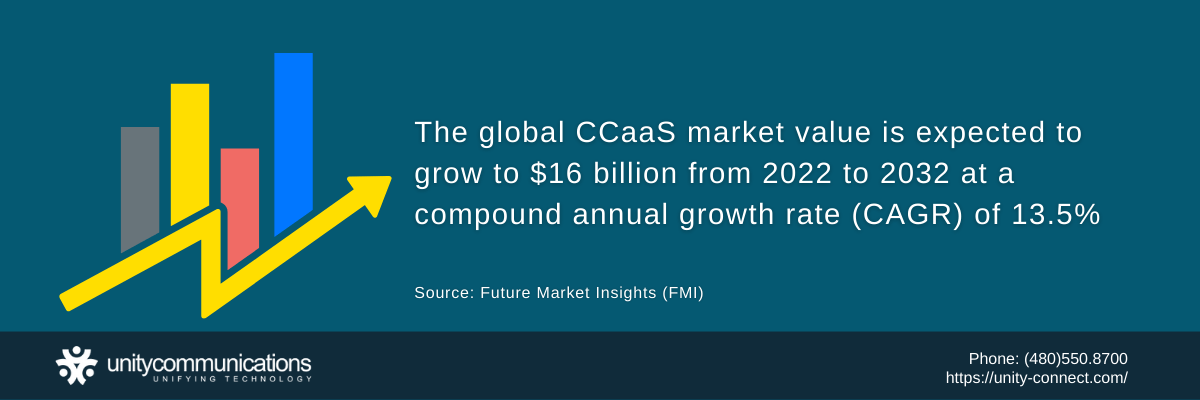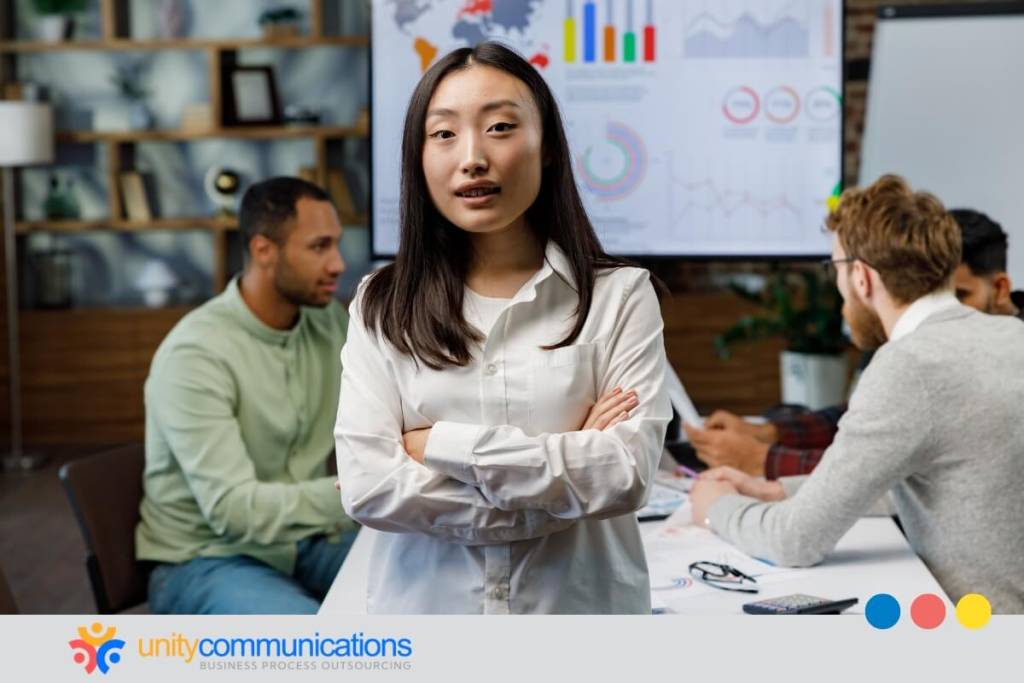Table of Contents
Industry experts view the future of the contact center as a service (CCaaS) market as promising.
Organizations among the first to adopt CCaaS have reported significant enhancements and growth. Consequently, an increasing number of businesses are incorporating contact center technologies into their operations, aiming to elevate their customer service, help desk support, and sales assistance.
This article explores the prospects of the CCaaS market. It delves into the reasons behind its rising adoption rate and the emerging technologies within the sector.
Continue reading to gain insights into the various challenges and issues encountered by both end-users and CCaaS providers.
Market Outlook for Contact Center as a Service

Future Market Insights (FMI) reports that the global value of contact centers as a service market might triple from 2022 to 2032. Experts suggest it may reach $16 billion at a compound annual growth rate (CAGR) of 13.5%.
Cloud-based software as services, advanced chatbots, and contact center solutions based on application programming interfaces (APIs) serve as boons for the market. The widespread use of these services contributes to CCaaS’ growth.
Contact Center as a Service Market by Segment and Industry
The FMI study notes that small and medium enterprises (SMEs) will be major end users of CCaaS. As more startups invest in cloud-based applications, SMEs will dominate the market, exhibiting a CAGR of roughly 12%.
Meanwhile, the large enterprise segment will corner a sizable market in the same period. Large companies have customers worldwide, so they have a sizable budget to keep their CCaaS operations running.
By industry, information technology (IT) and telecommunications will lead CCaaS market expansion. Both sectors depend heavily on customer interactions. That is why they need more efficient contact centers with enough data and operational security.
Additionally, different industries have gone completely virtual because of the pandemic. This has made it easier to adopt CCaaS on a large scale. The IT and telecommunications segment is estimated to post over 40% of market revenue.
Contact Center as a Service Market by Region
According to the FMI study, North America will continue leading the global CCaaS industry, securing 35% of the market share. The region, comprising the U.S. and Canada, is home to many established and significant contact center service providers.
On the other side of the globe, Asia-Pacific will be the fastest-growing region, with China and Japan leading progress. Ecommerce, industrial growth, and SMEs’ adoption of contact center technology drive the CCaaS market in this region.
Finally, Europe will show a CAGR of 12% in the same period. The release of the latest automated contact center solutions underpins this uptrend.
Why Is the CCaaS Market Experiencing Significant Growth?

The continued growth of the CCaaS industry can be attributed to high demand. Below are factors that influence this demand.
1. Omnichannel Communication Function
According to UC Today, organizations’ agents are empowered with new and easy ways to know and manage their customers. Meanwhile, customers benefit from a smooth and satisfying experience. Businesses whose customers want expert guidance enjoy huge opportunities with omnichannel functions.
CCaaS provides full omnichannel communication support for various platforms and devices, making a business more accessible to its current and potential customers.
Omnichannel integrates all communication modes into a single system for seamless consumer interaction. This means conversations continue even when customers switch from one channel to another. Customers no longer have to repeat information when interacting with a different agent.
2. Lower Total Cost of Ownership (TCO)
According to Lantellegence’s sample computation, CCaaS can take over 48 months to reach breakeven for 80 to 140 agents. Despite this, it remains a strong option considering the long-term value of the service and its minimal TCO.
TCO computes the direct and indirect costs of purchasing, acquiring, or investing in a service or solution. Direct expenses refer to the costs of buying products and services. Indirect expenses include maintenance, installation, technical support, employee training, and upgrades.
TCO enables businesses to:
- Improve decision-making;
- Budget appropriately for future expenditures; and
- Hone their competitive edge.
3. Mainstream Third-party Software Integration
CCaaS solutions are compatible with various third-party technologies, including support ticketing, marketing automation, and customer relationship management (CRM) applications. It commonly works with CRMs such as Zoho and Salesforce, project management platforms such as Asana, and communication platforms such as Slack.
4. Adaptable Services
CCaaS adoption goes beyond the customer experience. About 90% of contact centers switched to the cloud because it offered financial flexibility and service scalability.
CCaaS lets users add or remove features, functions, and capabilities based on the company’s needs or conditions. In addition, businesses can reduce or increase the size of their hired team of contractors without disrupting their operations.
With scalability, companies can be more flexible and cost-efficient and enjoy a hybrid work arrangement.
5. Advanced Reliability
CCaaS is 27% cheaper compared to on-site contact centers with 35% less downtime.
It is cost-effective because providers maintain the servers, and there is little hardware and software investment. Several providers even guarantee only five minutes of downtime per year. This capability ensures that IT, sales and marketing, and customer support teams operate smoothly despite adverse situations.
A stable system helps improve consumer satisfaction and team productivity. Reliable CCaaS providers offer continuous support and keep revenue losses to a minimum, even eliminating them in some cases.
6. Compatible With Smart Technologies
Cloud infrastructure helps contact centers adopt newer and smarter technologies to improve business processes. For example, conversational artificial intelligence (AI) has been an important part of the contact center experience.
Contact centers need CCaaS because it integrates with next-generation applications such as AI, machine learning (ML), natural language processing (NLP), and big data. These technologies simulate contact center agent conversations and give limited awareness to inanimate devices.
Using next-generation tools with CCaaS improves key performance indicators (KPIs) and reduces operating costs. You can also learn, review, and resolve customer problems and frustrations during the first interaction.
7. Flexible Costing System
Providers in the contact center as a service market charge their clients on a pay-as-you-go (PAYG) basis. It is the same billing system used by utility companies. Service providers charge based on your usage during a given period. The concept is simple and practical: the higher your consumption, the higher the cost.
The PAYG model helps businesses:
- Enhance revenue;
- Reduce investment costs; and
- Choose only suitable functions or features.
8. High Level of Information Security and Business Compliance
Sophos warned in its 2023 Threat Report that many barriers once faced by cybercriminals seeking to engage in malicious acts have been defeated. Last year was a very busy time for cybercriminals.
As a result, compliance with rules and standards set by the federal government and industry groups is a top priority for a cloud-based contact center provider. It helps businesses avoid big fines, criminal charges, civil lawsuits, damage to their reputation, and other consequences of non-adherence.
To protect data and fight against evolving cybercriminal activity, CCaaS providers closely track and comply with the following:
- International Classification of Diseases (ICD)
- International Organization for Standardization (ISO)
- Telemarketing and Consumer Fraud and Abuse Prevention Act
- Health Insurance Portability and Accountability Act of 1996 (HIPAA)
- General Data Protection Regulation (GDPR)
- Payment Card Industry Data Security Standard (PCI DSS)
9. Ideal for Work-from-home (WFH) Setup
CCaaS maximizes the benefits of telecommuting, where customers, technical, and sales support teams accomplish tasks away from physical offices.
The WFH arrangement reduces operating costs such as office rentals, equipment purchases, and maintenance. It also enables businesses to access a larger talent pool as more workers increasingly choose remote work over on-site or office jobs.
WFH employees, in many cases, are more efficient than in-house employees for the following reasons:
- Lower absenteeism and tardiness
- More productive periods
- More convenient work setup
What Are the Issues CCaaS End Users Face?

Organizations adopting CCaaS solutions might have some concerns. The next section offers a few examples of these concerns.
Migration to CCaaS Might Cause Workflow and Training Issues
When companies move their current call center operations to contact center platforms, significant workflow changes are required. The shift will likely occur across the organization to align all the business segments. With these changes come different processes, procedures, and methods.
But many users are initially opposed to new ways of doing things. You must upskill staff to accommodate workflow modifications, resulting in more expenses for your business.
Customer service, help desk, and sales support teams must learn specific skills or recalibrate their present competencies to use the updated platform fully. CCaaS retooling also involves investing more time and effort in adjusting to new processes.
CCaaS Solutions Might Not Blend Well With Existing Platform
A company’s internal applications and the IT system might encounter problems integrating with CCaaS. These issues occur when first implementing the solution. The contact service solution might not work properly with in-house technologies such as the enterprise’s proprietary software.
Incompatibility issues can lead to interruptions or stoppages that adversely affect operations and productivity. Out-of-sync applications disrupt agent-consumer interaction, impacting customer service and experience.
Exposure to Cybersecurity Threats
CCaaS solutions store a high volume of confidential and critical consumer and company data. A data breach or compromise is considered one of the biggest concerns among contact center providers. Despite tighter cybersecurity policies, data theft and unauthorized online access are more prevalent due to the ecommerce boom.
Cybersecurity threats can cause financial losses, regulatory penalties, and reputational damage. Threat actors can steal, illegally access, and sell data for cash, ruining their target’s image to customers.
What Are the Challenges CCaaS Providers Consider?
Read on to learn about the five potential threats virtual contact center providers must address:
- High client requirements. Some clients expect CCaaS partners to immediately decrease their operating costs. They believe that providers can frequently deliver high-quality service at the least expense. A third-party vendor typically does its best to provide excellent service within the client’s budget or at relatively lower costs.
- Unforeseen economic and political climate. The COVID-19 pandemic disrupted the global business environment. Domestic concerns, including civil unrest, recession, and political hostilities, will likely affect a service provider’s operations. Evolving regulatory policies and stricter controls might also impact the CCaaS market.
- High staff turnover. High employee resignation threatens the call center industry. The whole process of recruiting, hiring, and training new employees is time-consuming and expensive. The main reasons for high turnover are stiff market competition and employee health problems due to irregular work shifts.
- Frequent technological and power difficulties. In emerging economies, power outages and unstable phone lines are common issues among CCaaS providers. Beyond that, they must also address in-house technical troubles and poor internet connections. These challenges have adverse effects on consumer service and business revenue.
- Competent-talent shortage. A large number of skilled individuals enter the workforce every year. Despite this, it is incapable of meeting the rising demand for CCaaS. Service providers specialize in obtaining qualified personnel for the job. But due to the current trend, they find it challenging to get the right workers for positions.
What Are the Emerging Technologies in the CCaaS Market?

The following are some next-generation technologies CCaaS providers are expected to use in the coming years.
- Experience Communication as a Service (XCaaS) is a cloud communications platform that combines unified communications as a service (UCaaS) and CCaaS. Considered the next big disruptor in contact center technologies, XCaaS is likely to boost agent productivity to a higher level.
- Robotic process automation (RPA) utilizes software robots to accomplish specific duties, such as answering common customer questions, allowing human agents to focus on high-value tasks. RPA is applied in human resources, retail, payroll, customer service, help desk support, and sales support.
- ML-based cybersecurity is expected to grow, enabling enterprises to better anticipate online attacks and protect their networks. Since the pandemic, cybercrime has increased as more consumers use the internet to do business. As such, more companies are investing in stronger cybersecurity systems.
- Conversational AI drives and improves the conversational abilities of voice bots and chatbots. AI has advanced to the point that bots will soon be able to help consumers and human agents with more complicated issues and tasks. They will no longer be limited to simple duties and frequently asked questions (FAQs).
- Coaching software for remote agents identifies agent weaknesses and makes recommendations using AI. CCaaS providers will depend on automated coaches to supervise WFH employees and help them with work progress. The days of coaching support agents in person might be numbered.
- The Internet of Things (IoT) allows digital-enabled machines, such as TV sets, tablets, cars, mobile phones, computers, and washing machines, to become “smart things.” As such, consumers will more often turn toward self-service options instead of contacting CCaaS agents for help. Agents, in turn, will become more specialized in complex tasks.
The Bottom Line
The market for CCaaS is poised for continued growth and evolution worldwide, with an increasing number of businesses eager to adopt CCaaS solutions. Despite the typical challenges associated with any technology, the advantages, features, and functionalities offered by contact center services make them a worthwhile consideration.
If you are contemplating investing in CCaaS or are ready to implement the service, selecting the right partner is crucial for success.
For expert guidance, consider contacting a business process outsourcing (BPO) company like Unity Communications. As a seasoned outsourcing provider, Unity Communications is well-equipped to support and navigate you through the intricacies of your CCaaS investment.




